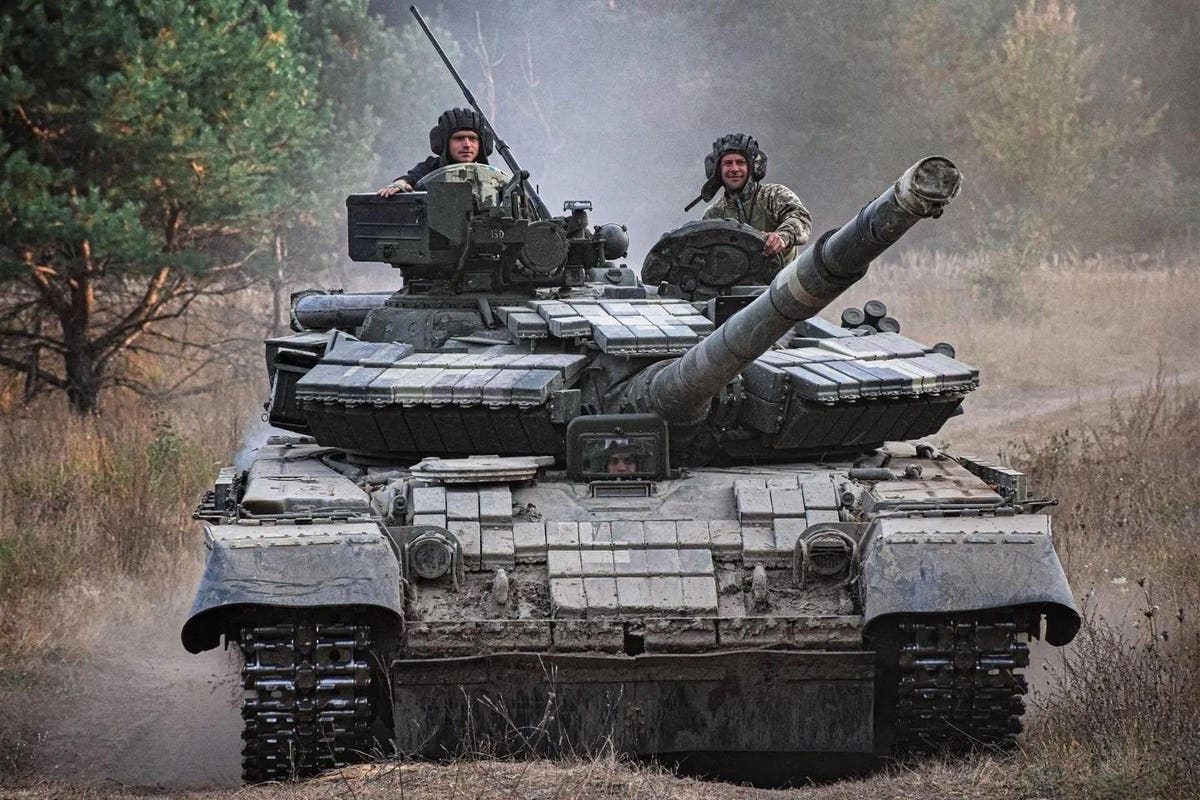In one of the most dramatic scenes from a war which has produced thousands of them, a new video shows an engagement between a Ukrainian T-64BV tank and a Russian T-90S at almost point-blank range. (Others identify the Russian as a T-72B3). In the video, widely shared on social media, the T-64, seemingly very much the underdog, comes out on top, apparently with the help of smart but cheap technology.
A double row of trees separates the two vehicles, which, using the length of the T-90S as a yardstick, are somewhat under a hundred feet apart. That would be incredibly close in any tank battle from WWII onwards, and even more so on the modern battlefield where analysts talk about the need for higher-velocity guns to increase engagement ranges to three miles or more.
The T-64BV and T-90S are fundamentally similar tanks derived from Soviet-era designs, the big difference being that the T-64 is a second-generation design and the T-90 is from the third generation that replaced it. The last T-64 was built in 1987, although Ukraine’s T-64BVs have been somewhat upgraded. The T-90S was originally developed for export, but was later adopted by the Russian army and has better armor, more advanced sighting system and a more powerful engine that the T-64BV.
Both tanks have similar 2A46M 125mm cannon, and in tank-v-tank encounter they would be use armor-piercing fin-stabilized discarding sabot (APFSDS) ammunition. The Russians may be using a later version which gives better accuracy and penetration at long range, but at handgun distances this would be irrelevant. Both tanks are easily capable of destroying the other at this range.
The Ukrainian tank gets off the vital first shot just as the Russian tank starts moving, scoring a hit that sends debris flying, though much of this may be from the T-90S’s Kontakt-5 explosive reactive armor; this is supposed to be effective against kinetic rounds but is of doubtful benefit at close range. A Russian crewman appears to bail out of the vehicle at 0:20, just before the Ukrainians fire again, creating more flying debris and leaving the T-90S smoking as the T-64 backs away.
The view switches to a different angle, but immediately after the first section judging by the drifting smoke, and the T-64 fires again. This time the T-90S is torn apart by an internal explosion. As an APFSDS round punches through armor it produces a shower of high-speed, white-hot metal fragments which comes through the interior like a gigantic shotgun blast. The resulting fireball sets off ammunition and fuel.
It is notable that throughout the encounter, the Russian tank’s gun barrel is pointed along the treeline; they did not have any idea that there was an enemy tank on the other side, whereas the Ukrainians seem to know exactly where the Russian tank is. The video is shot by two Ukrainian drones, and there may have been others watching the same action. It is reasonable to assume the drone operators kept the tank crew informed of the Russian’s location and movement, probably via software designed for the purpose.
Ukraine’s Delta situational awareness system is a network which processes data from drones, satellites, sensors and other sources and feeds it into a soldier’s real-time map display on a commercial tablet computer. Delta is a textbook example of the network-centric warfare which other nations have struggled to build for decades; it appears extremely effective and has performed well and successfully interfaced with NATO systems in exercises. Delta is widely credited with being a game-changer for Ukraine, enabling their forces to see and hit targets out of sight.
Delta is only as good as the data available, which is why small consumer drones have been so important in this war. Last year one regional Russian government complained that troops on the front line were “blind kittens” without quadcopters, at the mercy of Ukrainian forces who could see them without being seen. Ukraine has supplied forward troops with thousands of small ‘Mavic’ type quadcopters, and aims to get 200,000 of them in the field this year. Russia has been not far behind.
Usually the combination of drones and smart software is most effective at long range, and a Ukrainian gunner has claimed the longest-range tank-to-tank kill ever recorded, lobbing shells at a Russian tank six miles away and well out of sight. It took the gunner twenty rounds, but it was a one-sided shooting match.
This latest encounter underlines the bravery and determination of a Ukrainian tank crew taking on a superior opponent. But it also shows how the side that fails to embrace new technology is lost. Leopards, Abrams and Challengers are all excellent tanks, but future tank developers might consider that expensive next-generation vehicles with slightly improved armor, guns and engines will still be easily destroyed by smart adversaries with lesser tanks who have invested in cheap tablets, drones and open-source software.
Read the full article here





